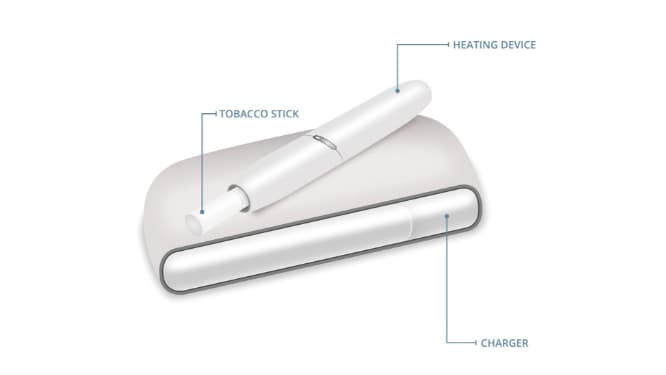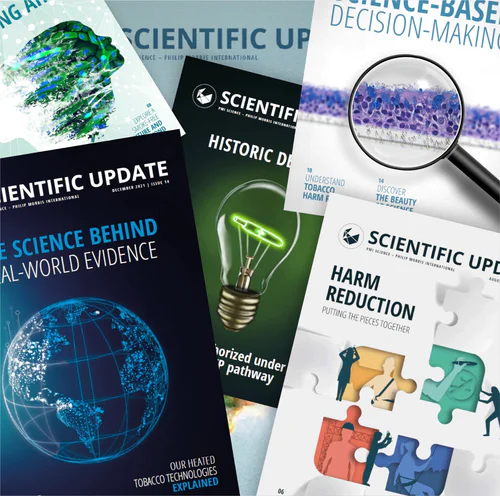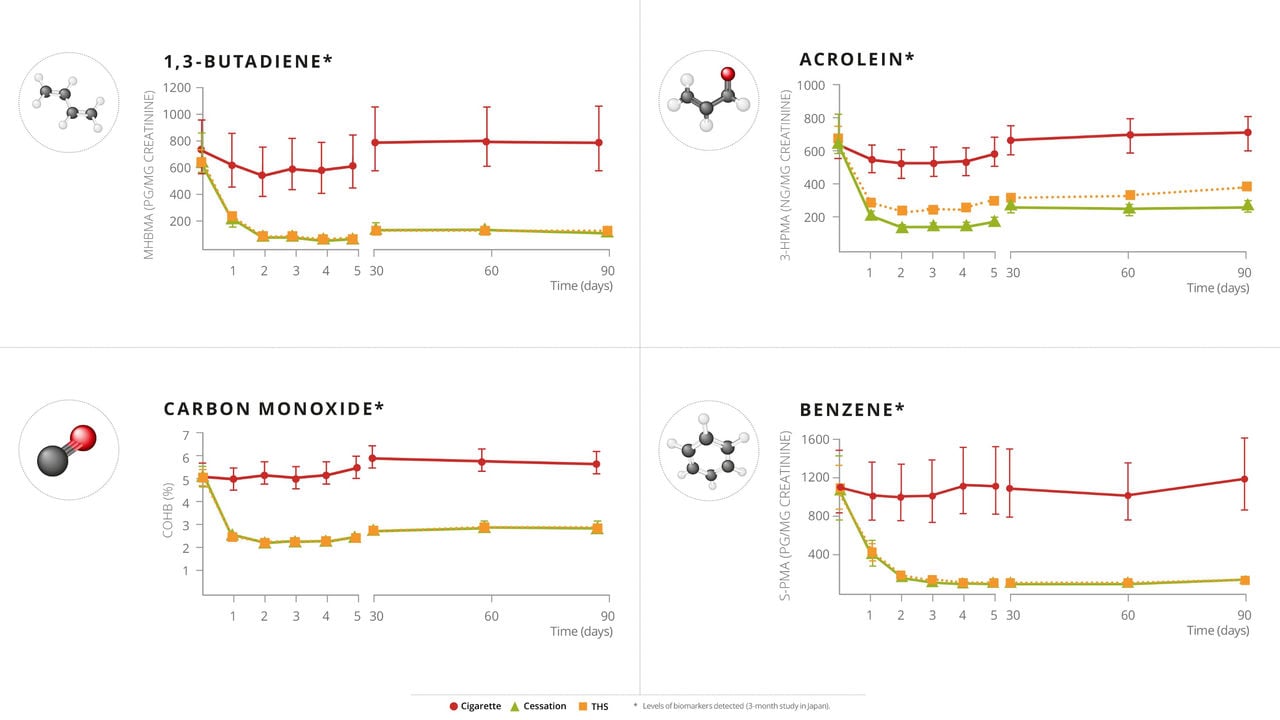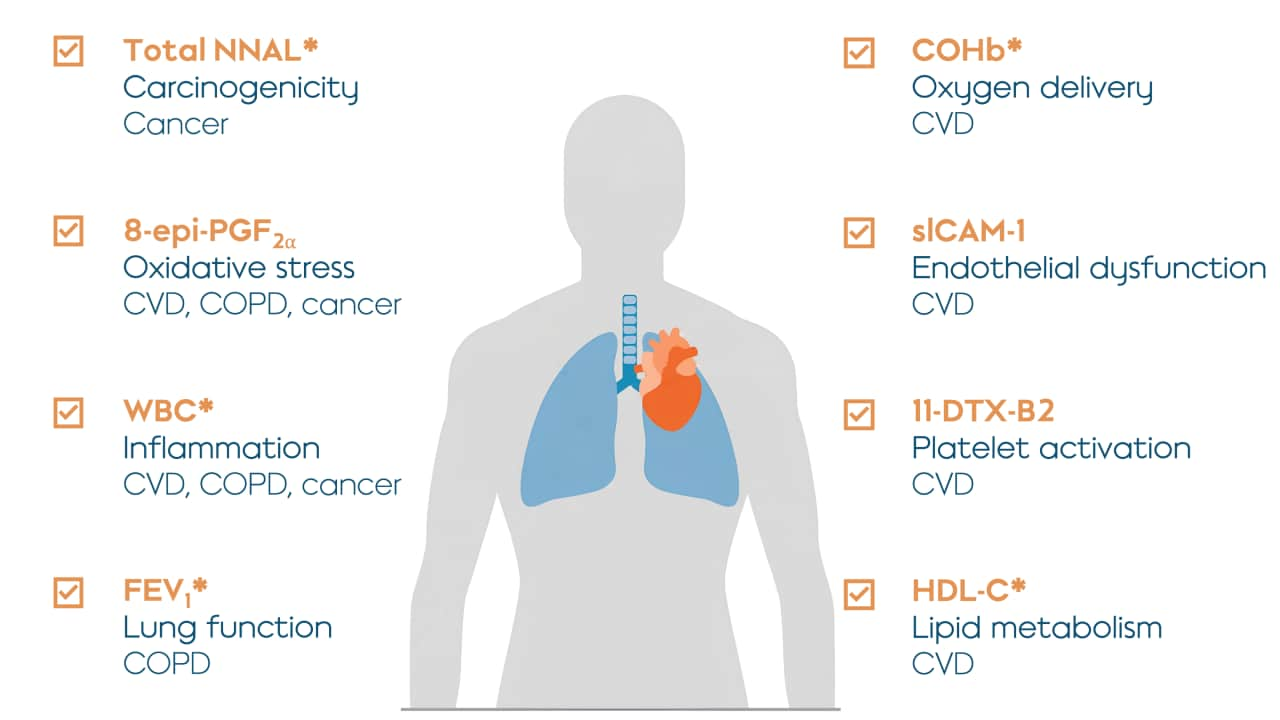Tobacco harm reduction
What are heated tobacco products?
HTPs are a range of relatively new products that were developed and assessed to reduce the harms associated with smoking for adult smokers who would otherwise continue to smoke cigarettes. Unlike cigarettes, HTPs heat the tobacco without burning it. This creates an aerosol that contains nicotine, as well as much lower levels of harmful chemicals than cigarette smoke. Both of these points should be confirmed for each product via scientific assessment. Even so, the best choice is to quit nicotine and tobacco products altogether.
In this category, you have products that vary in tobacco heating temperature (though all below the ignition point of tobacco), heating sources, tobacco processing, flavors, and designs, with new technologies still in development. So, although HTPs are a class of products, each specific product really needs to be assessed separately.

Most heated tobacco systems have the same basic parts: a heating device, the tobacco stick, and a way of charging the heater. Our Tobacco Heating System (THS) serves as one example.
How do they work?
HTPs heat tobacco, sometimes by means of e-vapor passing through the tobacco portion at temperatures well below combustion (burning). How the heating source works depends on the product, but in all cases the heat aerosolizes nicotine directly from the tobacco. The user draws on the mouthpiece to inhale the nicotine-containing aerosol.
Because the tobacco is heated and not burned, the aerosol that’s inhaled is fundamentally different in composition from cigarette smoke. HTPs contain tobacco, which is why they can provide a taste and nicotine delivery similar to cigarettes. At the same time, the number and levels of other toxic chemicals in the aerosol may vary from product to product, but should be reduced compared with cigarette smoke.
Are HTPs the same as electronic cigarettes?
No, they’re not the same. HTPs heat tobacco to generate a nicotine-containing aerosol directly from specially processed tobacco, while e-cigarettes vaporize an e-liquid containing nicotine and flavors. Both are types of smoke-free products that can deliver a nicotine-containing aerosol and—when scientifically substantiated and regulated—can be a better alternative to cigarettes for adults who would otherwise continue smoking. Since both product types generally deliver nicotine, they are addictive. Neither product type is risk free. The best choice for any smoker is still to quit tobacco and nicotine altogether.
Are HTPs safer than cigarettes?
HTPs are not risk free. They have the potential to contribute to better health outcomes for adult smokers who switch to them completely, since they can significantly reduce exposure to the toxicants in cigarette smoke that are known to cause smoking-related diseases.
Quitting tobacco and nicotine use altogether completely eliminates the exposure to these toxicants and is certainly the best way for a smoker to reduce the risk of smoking-related diseases. But many smokers do not quit. HTPs are for those men and women who would otherwise continue to smoke. They should be encouraged to switch completely.
Do HTPs expose users to new chemicals?
HTPs are a class of products, which means the aerosol from each product must be individually assessed. For our THS,* it is estimated that 99.7% of the emitted aerosol is of known composition. The results demonstrated a 90-95% reduction in the average levels of harmful and potentially harmful constituents (HPHCs) compared with reference cigarette (3R4F) smoke and fewer chemicals in the aerosol than in cigarette smoke.(1)
Three chemicals were identified in the aerosol of THS that were not in the smoke from the reference cigarette, but all of these chemicals have previously been reported in the smoke of marketed cigarettes. This means that there are no unique chemicals in the HTP aerosol. While some chemicals are found at higher levels in the aerosol of THS compared to cigarette smoke, U.S. Food and Drug Administration (FDA), in their review of our data, has concluded that, “these chemicals are present in very low levels and potential effects are outweighed by the substantial decrease in the number and levels of HPHCs (harmful and potentially harmful constituents) found in combusted cigarettes”.(2)
Is there secondhand exposure from HTPs?
Indoor air quality studies are an important part of assessing the overall reduced-risk profile of HTPs. Studies on the use of HTPs indoors focus mostly on THS, showing that the levels of HPHCs in the air can be dramatically reduced compared to cigarettes, but not entirely eliminated. Most of the chemicals analyzed were detected at levels indistinguishable from background with the exception of nicotine, acetaldehyde, and glycerin. The levels of nicotine and acetaldehyde were well below the levels measured when cigarettes were used, and all were well below the thresholds defined in air quality guidelines. Based on these results, THS use causes no negative impact on indoor air quality.
For THS, this led U.S. FDA to conclude that “reduced HPHC (harmful and potentially harmful constituent) exposure also is beneficial for those who would be secondarily exposed to the aerosol [of THS] as compared to environmental tobacco smoke”.(2)
Is HTP use common among nonsmokers and youth?
Although there are a limited number of studies that have researched HTP uptake by never smokers, former smokers, and youth, there are some data available, mostly from countries where THS is sold. Generally, the data show that the population most likely to use THS are current smokers, with low uptake by youth and nonsmokers, and a slightly higher, but still low likelihood of uptake in former smokers. Data from studies conducted in Japan,(3) Germany,(4) and Switzerland(5) by local health ministries and organizations find that HTP use among youth are in the low single-digits while cigarette use tends to be higher among the same age groups.
Studies may show conflicting results, but it’s important to remember that “trying” a product is not the same as “established use” of a product. The 2010 Global Youth Tobacco Survey Italian data showed 60.3% (CI 52.7–67.3) of participants aged 15 replied yes to the question “Have you ever tried or experimented with cigarette smoking, even one or two puffs?” Compared to that value, 12.7% (CI 9.1–17.5) of the study participants reported smoking cigarettes daily.(6)
Any additional thoughts?
Not all tobacco products are the same. They exist along a continuum of risk between combusted tobacco at the most harmful to complete cessation of nicotine and tobacco products altogether. Risk proportionate regulations could help encourage adult smokers who do not quit to switch to better alternatives.
Scientists— both in the tobacco industry and outside of it— as well as regulators and public health authorities continue to build the evidence on HTPs. Together, we have the responsibility to promote research and assess the evidence on HTPs as it evolves in order to fully understand the benefits and risks of these products. This includes monitoring product use behavior to ensure that HTPs are marketed in a way that encourages adult smokers to switch while minimizing uptake by nonsmokers and youth.
* THS is marketed under the brand name IQOS.
This article is a feature from Scientific Update 10.

Read the Scientific Update magazine
The Scientific Update magazine is focused on PMI's research and development efforts, milestone studies, industry regulations, and more. View the latest issue, or read the articles online.




